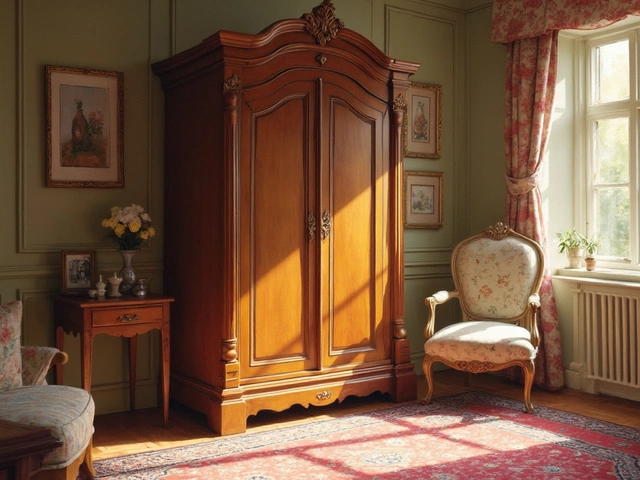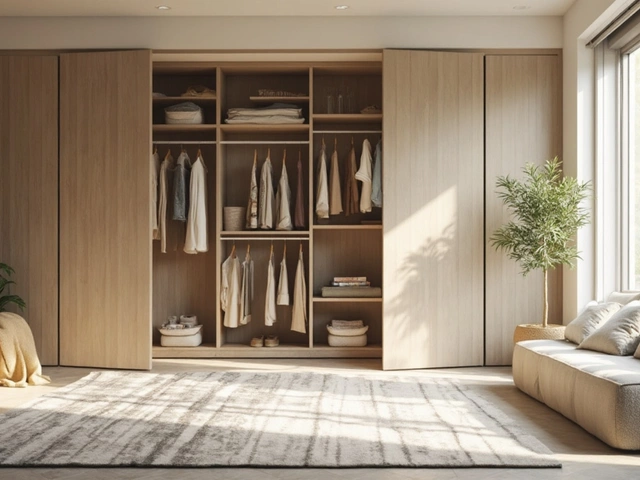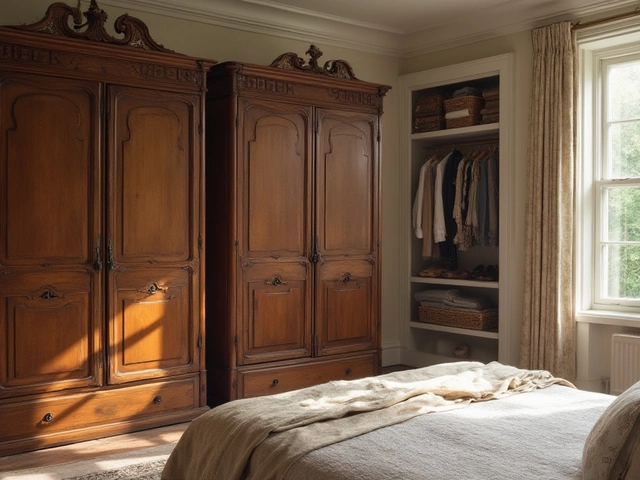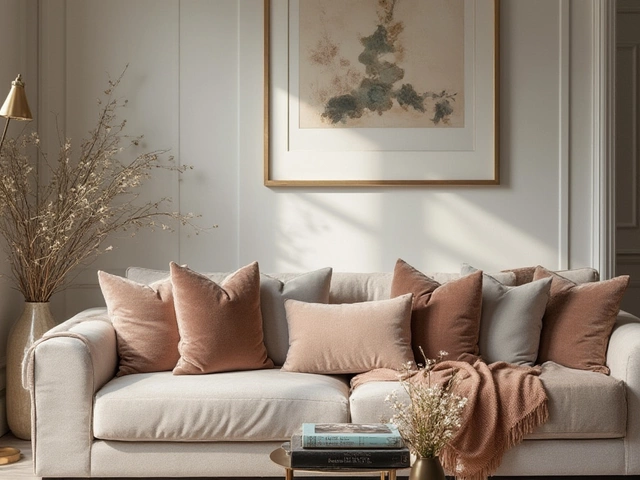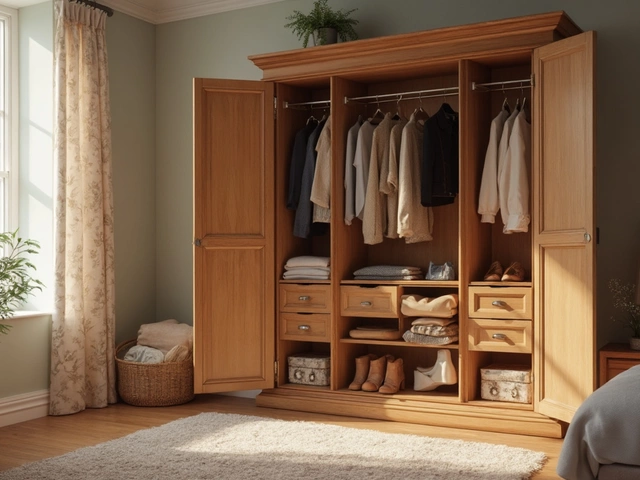 22
Jun,2025
22
Jun,2025
Most people just shove their coffee table in the middle and call it a day. Sound familiar? The truth: where you put your coffee table changes everything—how comfy your space feels, how easy it is to walk around, and even whether you bash your shin every time you try to sit down.
Start with the basics. The best distance between the edge of your sofa and your coffee table is usually 16 to 18 inches. That’s enough space to move around without it feeling like you’re scrambling over furniture to grab the remote. Go tighter, and you’re in bruise territory. Any wider, and you might as well keep snacks across the room.
If your room is tiny, don’t panic. You can still fit a coffee table without making it feel stuffed. Sometimes the shape you choose is even more important than where you put it—oval and round tables, for example, take up less visual space and are way more forgiving in awkward layouts.
- How Far Should Your Coffee Table Be from the Sofa?
- Dealing with Small or Awkward Spaces
- The Right Coffee Table for Your Room
- Making Space for Kids and Pets
- Styling Tricks That Change the Game
How Far Should Your Coffee Table Be from the Sofa?
The sweet spot for placing your coffee table is all about keeping things comfortable and practical. Most interior designers, including mass-market names like West Elm and IKEA, recommend 16 to 18 inches between your sofa and your coffee table. This isn’t just some random number—grab a tape measure and you’ll see it’s just right for grabbing a drink or the remote without straining. Yet, you still have room to walk by without smashing your knees.
Need numbers you can trust? Check out this quick reference:
| Room Element | Ideal Distance |
|---|---|
| Sofa to Coffee Table | 16-18 inches (40-46 cm) |
| TV Stand to Coffee Table | 24-30 inches (61-76 cm) |
| Coffee Table Height | Same as sofa seat or up to 2 inches lower |
So why does this matter? If your table is too close, sitting down or getting up turns into a daily obstacle course. Set it too far, and now it’s useless for anything besides collecting dust. Trust me, I once made the mistake of leaving a two-foot gap—and watched guests awkwardly stretch for snacks all night.
Here’s how to nail it every time:
- Measure from the edge of your sofa’s seat (not the back or arm) to the closest edge of your coffee table.
- Sit down and reach for an imaginary cup—can you get it easily without having to lean way over?
- Leave at least 24 inches between the coffee table and the TV stand or any large piece across from it so there’s a clear walkway.
- If you’ve got kids or pets running around like Tigger (my cat, who loves skidding under our table), an extra inch or two of space can prevent tripping or spilled drinks.
Think of the coffee table placement as the anchor of your living room: functional, central, and never in the way. Get this right, and everything else just works better.
Dealing with Small or Awkward Spaces
Small living rooms and weird-shaped layouts can turn picking a coffee table placement into a puzzle. But there are real tricks that work in tight spots, without forcing you to ditch having a table at all. Here’s how to make it work, even if your space looks impossible.
First, pay attention to shape. Round and oval tables are lifesavers in small rooms—they keep everyone from hitting corners (great for both wobbly toddlers and clumsy adults like me). Lucite or glass tables are another smart move, because they let light through and trick your eyes into thinking there’s more space than there really is.
If you literally don’t have walking room, nest tables or a small ottoman work in a pinch. Push them aside when you need floor space, pull them close if you’ve got guests and need a spot for drinks. Stackability is a game changer in apartment living or studios; IKEA sells nesting tables that can tuck right under each other.
Another tactic: don’t center the table in the room. Instead, cheat a little—pull it closer to the main seating. In places with only a loveseat or a single chair, a C-shaped table that slides over the couch arm is a real hack. That’s what I did when Lucy and I had our first tiny apartment, and it made movie nights so much easier (and Tigger couldn’t knock anything off for once!).
| Table Type | Best For | Bonus Points |
|---|---|---|
| Round | Open paths, no bruised shins | Feels softer, safer for kids |
| Glass/Lucite | Letting light through | Makes room feel bigger |
| Nesting | Flexible use, small footprints | Hide away extras when not needed |
| C-shaped | Very tight rooms, solos | Slides right up to your seat |
Don’t be afraid to skip a traditional setup. You might try an off-center table, or use a stool as a side table when the main spot just won’t work. The key is to keep traffic flowing and avoid making the space feel crammed. Before you buy, measure your walking gaps—a tape measure can save a lot of frustration. Even six extra inches can mean the difference between easy living and daily stubbed toes.
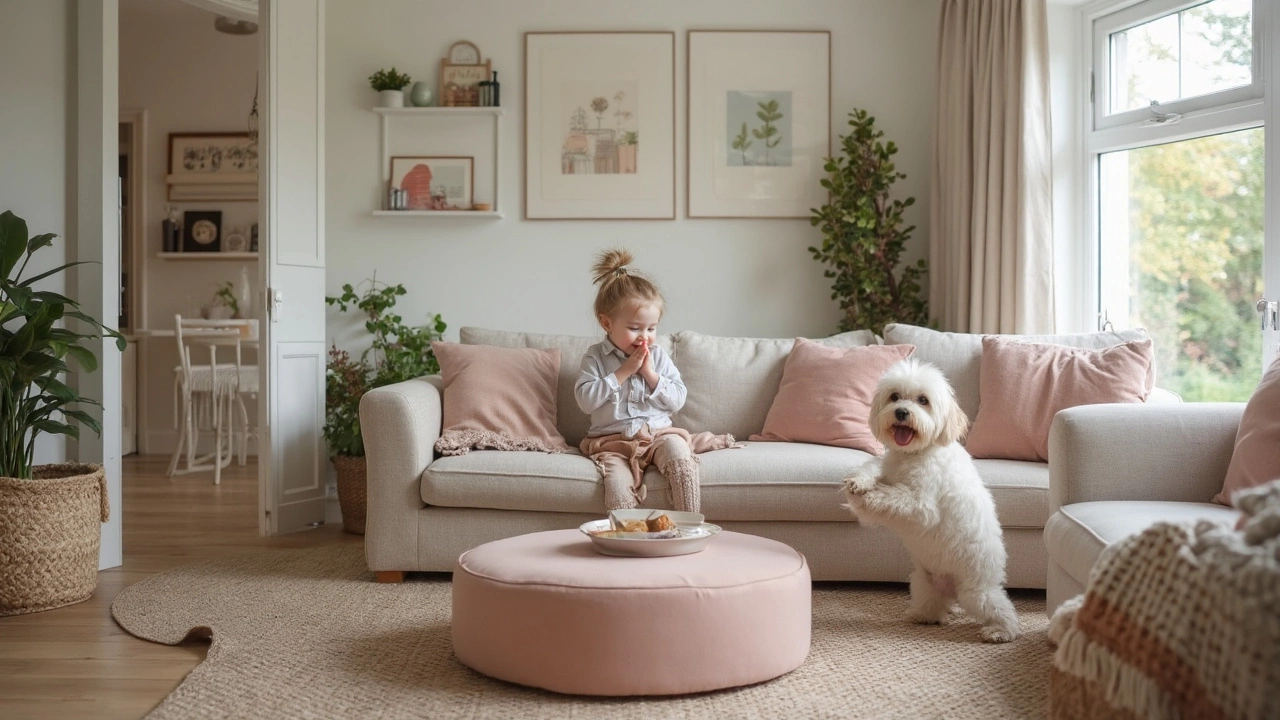
The Right Coffee Table for Your Room
This is where most folks get tripped up. Just because you saw a coffee table look good in a showroom doesn’t mean it’ll work in your place. You want to focus on three big things: size, shape, and function.
First, check the size. Your coffee table should be about two-thirds the length of your sofa, give or take. If your couch is 90 inches long, shoot for a table around 60 inches. Height matters too—ideally, the table will line up within two inches of your sofa seat height. Coffee tables that are too tall or too low look out of place and end up feeling awkward when you set drinks down or try to use them for games or snacks.
Shape’s the next point. Rectangular tables usually work for longer couches. Got a smaller or square-shaped seating area? Try a round or square table—they steal less space and are friendlier if you’ve got kids darting around (no sharp corners!). If you like rearranging furniture a lot, lightweight or nesting tables are super handy. My friend tried one big circle table and hated how it blocked traffic, so he swapped to two smaller round tables and now it’s way easier to move around when guests come over.
Function’s huge too. Ask yourself: does it need to hide clutter? Lift-top models are brilliant for hiding remotes, toys, or even your mess when guests pop by unexpectedly. Some tables double as extra seating or mini desks. If you don’t want to stress about stains or scratches, go for finishes that are easy to clean—there’s nothing worse than worrying anytime someone puts a cup down.
Let’s get specific. Here’s a quick breakdown to help you find the sweet spot for your space:
| Living Room Size | Suggested Table Shape | Recommended Table Size |
|---|---|---|
| Small (under 120 sq ft) | Round, Oval | 24-34" diameter or length |
| Medium (120-200 sq ft) | Rectangular, Square | 36-48" length/diameter |
| Large (over 200 sq ft) | Rectangular, Modular | 50-60" length or pair two tables |
And if you really want your coffee table placement to look intentional, leave about 18 inches of space around the sides so you can move through the room without tripping over Tigger (my cat is practically a speed bump).
If you remember anything: measure before you buy, and think about how you’ll actually use your coffee table instead of just how it looks. The right call makes your whole living room flow better, period.
Making Space for Kids and Pets
If you’ve ever watched a toddler charge through the living room, or you’ve had a cat like Tigger leap onto the coffee table, you know this: not just any table placement works. When you’re dealing with kids or pets, leaving the right space around your coffee table placement means less stress—and fewer messes.
Rounded edges on tables are way safer than sharp corners, especially when you’ve got young kids who are basically at furniture-height. According to the Consumer Product Safety Commission, over 40,000 children in the U.S. end up in the ER every year due to coffee table injuries. That’s a hefty reminder not to go for those scary glass tables or anything top-heavy that a wobbly toddler could knock over.
Let’s talk practical tips if you’re juggling both kids and pets:
- Leave enough clearance: 18 inches is the sweet spot for walkways, strollers, and zooming pets.
- Choose tables with storage. Hidden shelves keep toys out of sight and cat paws out of trouble.
- Opt for lighter materials. If your table gets knocked, it won’t crush toes or paws.
- Avoid glass. It shows sticky handprints, scratches, and is quick to shatter.
- Use grippy pads or non-slip rugs under the table, especially if your floor is slippery.
Here’s how some popular coffee table materials really hold up to family chaos:
| Material | Safety for Kids | Pet-Proof? | Maintenance |
|---|---|---|---|
| Wood (Rounded) | High | High | Easy to clean |
| Metal | Medium (edges matter) | Medium | Wipes down easily |
| Glass | Low | Low | Constant cleaning needed |
| Ottoman-Style | Very High (soft edges) | Very High | Easy, but stains possible |
Pet hair floats everywhere. Trust me—I have Tigger, and she somehow manages to cover furniture in fur. Choosing a solid top (instead of slatted) keeps little parts and pet hair from hiding out of sight. And when in doubt, go for something you can wipe clean fast.
As design expert Emily Henderson puts it,
“If a living space serves every member of your household—including four-legged ones—comfort and utility always win over looks.”Kid- and pet-proofing doesn’t mean you give up style; it just means you care about function just as much as looks. And if you find crayon scribbles or the cat has claimed your table as a throne? Welcome to real life—it means your coffee table is right where it needs to be.

Styling Tricks That Change the Game
This is where you can either make your coffee table blend in or stand out. Small changes here can shift the vibe of your entire living room. Remember, the coffee table placement does half the job, but the way you style it seals the deal.
If your table seems to disappear or look out of place, it’s often because it’s either too cluttered or too bare. The sweet spot is usually three things on the table—but make each item pull its weight. For example, stack two eye-catching books, add a quirky bowl for keys or remotes, and maybe throw in a pop of green with a small plant. Odd numbers catch the eye without trying too hard.
Worried about your space looking jammed up? Use a tray. Trays help group items, make things look organized, and let you slide everything away fast if you need space for game night or if your cat decides it’s nap time (Tigger does this at my place every other day).
Here’s something interesting: a coffee table with an open base or legs can make the room feel less crowded—nothing blocks your line of sight. And if you want the room to feel brighter and bigger, tables with glass tops bounce light around, making everything seem airier.
If you’re a data fan, check this out. Most interior designers agree these styling rules work best:
| Styling Trick | Percentage of Designers Who Recommend |
|---|---|
| Use of groups of 3 items | 85% |
| Adding a plant or greenery | 78% |
| Using trays for organization | 64% |
| Mixing heights & textures | 71% |
| Glass or open-base tables for space | 69% |
If you’re into changing things up with the seasons (or when boredom hits), swap out those styling accessories quickly—a new candle, a bright book, or even a different bowl can totally refresh your setup.
One last tip: watch the height of your decorations. Nothing should block your view when you’re sitting. If you can’t see the TV, the person across from you, or your pet making a mad dash through the room, that’s a sign to dial it back.
